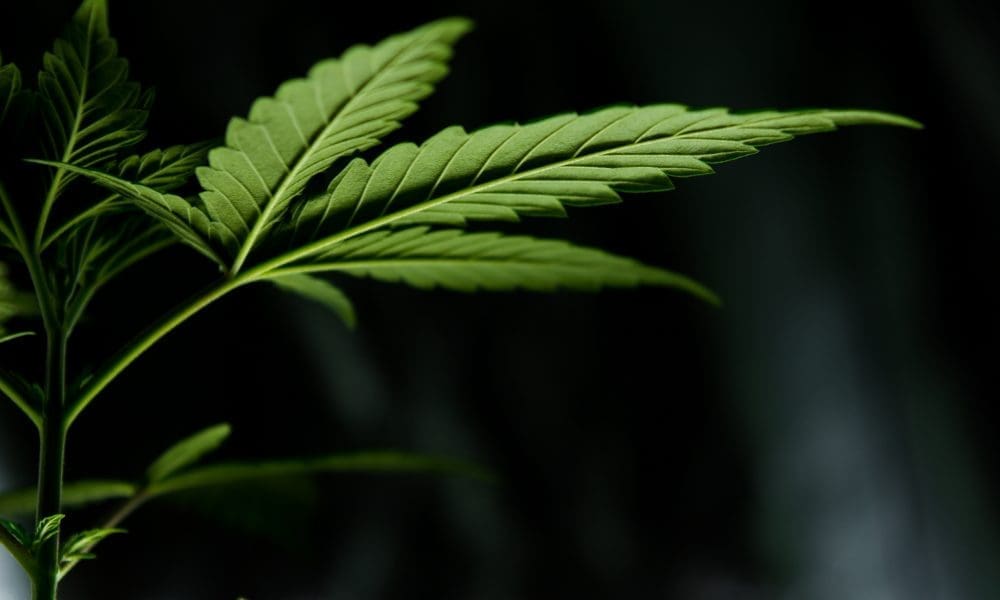[[{“value”:”
Officials at the U.S. Department of Veterans Affairs (VA) are looking for contractors who can analyze and explain scientific evidence on medical marijuana to clinicians and the general public, including about its potential benefits for conditions like PTSD as well as potential risks around cannabis use disorder and consumption during pregnancy.
In a so-called “sources sought noticed” published last week, VA said that of the 9 percent of military veterans who report using cannabis in the past year, about 40 percent said they used marijuana to treat a condition or manage symptoms. The trouble comes when veterans try to talk to VA doctors about use of the drug.
“In short, clinicians will encounter patients who are using cannabis or who have questions about using cannabis,” the notice says. “Discussions about cannabis are challenging in part because evidence examining the benefits and harms of cannabis is growing and changing rapidly, and because of the variability in the way the existing evidence base has been interpreted.”
“Currently,” the six-page document notes, “there is no comprehensive, independent, updated cannabis evidence resource for the health care sector that synthesizes what is known from research and what is left to learn.”
The sources sought notice is seeking “information regarding the availability and capability of all qualified sources” to perform the work, titled Systematically Testing the Evidence of Marijuana (STEM).
The department listed three main goals of the STEM project:
Educate clinicians about the evidence, and its quality, regarding the benefits and harms of cannabis in order to facilitate discussions with their patients
Identify specific research gaps to help researchers design high-yield studies that will advance the field
Provide resources for patients and the general public about cannabis-related evidence
Over a yearlong period, the contractor would be expected to conduct “literature surveillance” and create “living systematic reviews” on five topics, including PTSD, cannabis use during pregnancy, cannabis use disorder, the treatment of cannabis use disorder and cannabis for mood disorders.
“This contract is required to obtain the research and policy staffing services needed to update those reviews and implement best practices for them to be publicly accessible, ‘living systematic reviews,’” the notice explains.
The contractor would also adapt the work “for dissemination on the existing STEM website and through other means (conference presentations, seminars, and journal publications).”
Work would be overseen by a principal investigator at VA with “expertise in evidence-based medicine methodology and the conduct and reporting of systematic reviews,” the department said. That person would meet “at least biweekly…to help ensure continued progress and oversee quality assurance.”
Potential contractors are asked to email a provided VA contact no later than April 7.
The existing STEM website is a collaborative project between VA and Oregon Health & Science University’s Center for Evidence-Based Policy. It’s funded by VA’s Office of Rural Health.
The new VA notice points out that a quarter of U.S. veterans live in rural areas, meaning “the number of rural Veterans using cannabis is substantial.” It adds that the most commonly cited clinical reasons for cannabis use “are highly relevant to care of rural Veterans and Veterans in general, and include pain, PTSD, anxiety, and insomnia.”
A separate federally funded study of military veterans published earlier this year, meanwhile, found that 40 percent of military veterans suffering from chronic pain reported using marijuana to treat symptoms.
Most said it helped them deal with pain, mobility and sleep issues, while substantial numbers of veterans also say they used cannabis for PTSD, anxiety and stress. Nearly all participants (98 percent) said healthcare providers should discuss the use of natural products with their patients.
Authors from the University of California, San Francisco, and Yale University noted that the percentage of respondents reporting cannabis use “may represent under-reporting related to the prohibition on cannabis prescribing in the VA as a federal health care system.”
Notably, only about half of respondents overall said they’d discussed natural product use with their healthcare providers. Authors noted, however, that “clinicians and pharmacists generally lack knowledge about NPs, which explains why they may avoid discussions about NPs with their patients.”
At a joint hearing earlier this year, meanwhile, two veterans service organizations submitted testimony voicing support for expanded access to plant-based medicines, including marijuana and psychedelics.
“Currently,” said Allison Jaslow, CEO of Iraq and Afghanistan Veterans of America (IAVA), “veterans who live in states where cannabis has been legalized completely are unable to even be prescribed cannabis for medicinal purposes by their doctor” at the VA.
Jaslow said IAVA is “looking forward” to the reintroduction of a bipartisan bill—the Marijuana Safe Harbor Act—that would temporarily allow veterans to legally possess and use cannabis under federal law, as recommended by doctors in accordance with state law. VA physicians would also be allowed for the first time to issue such recommendations.
Aside from that legislation, there have been veterans-focused cannabis measures already filed in the 119th Congress. That includes a bill sponsored by Rep. Brian Mast (R-FL), co-chair of the Congressional Cannabis Caucus, whose Veterans Equal Access Act would similarly allow VA doctors to recommend medical marijuana to their patients in states where it’s legal.
Other VSOs also addressed marijuana and psychedelics policy with the bicameral committees at previous hearings last month, urging lawmakers to continue to explore the alternative therapeutic options and expedite access if they’re proven to be efficacious.
Research published in 2023 found that more than 90 percent of U.S. military veterans who use medical marijuana reported that it improved their quality of life, with many using cannabis as an alternative to over-the-counter and prescription medications.
In July of last year, a Senate committee urged the VA to explore medical marijuana as an alternative to opioids for veterans, also asking the agency to consider allowing its doctors to formally recommend cannabis to their patients.
As for marijuana and chronic pain, a recently published scientific review concluded that cannabinoids may be useful treatments for various types of chronic pain, in some cases helping to reduce the use of other medications. The paper also said select mixtures of cannabinoids could help minimize undesirable effects of cannabis, such as the psychoactivity of THC.
Published in the journal Medical Cannabis and Cannabinoids and authored by researchers at Penn State College of Medicine, that paper reviewed “the most recent evidence supporting the use of cannabis in the treatment of chronic pain disorders including chronic neuropathic pain, cancer-induced neuropathic pain, chronic musculoskeletal pain, and chronic headaches and migraines.”
Research published earlier this year in the journal Pain also found that marijuana was “comparatively more effective than prescription medications” for treating chronic pain after a three-month period, and that many patients reduced their use of opioid painkillers while using cannabis.
The analysis “was able to determine, using causal inference techniques, that use of medical marijuana for chronic pain under medical supervision is at least as effective and potentially more effective in relationship to patients with chronic pain treated by prescription medications (nonopioid or opioid),” said the report, by authors at the University of Pittsburgh, Harvard Medical School and the National Cancer Institute.
A separate federally funded study found that legalization of marijuana in U.S. states is associated with reduced prescriptions for opioid pain medications among commercially insured adults—indicating a possible substitution effect where patients are choosing to use cannabis instead of prescription drugs to treat pain.
“These results suggest that substitution of cannabis for traditional pain medications increases as the availability of recreational cannabis increases,” authors of that report wrote, noting that there “appears to be a small shift once recreational cannabis becomes legal, but we see stronger results once users can purchase cannabis at recreational dispensaries.”
Other recent research also showed a decline in fatal opioid overdoses in jurisdictions where marijuana was legalized for adults. That study found a “consistent negative relationship” between legalization and fatal overdoses, with more significant effects in states that legalized cannabis earlier in the opioid crisis. Authors estimated that recreational marijuana legalization “is associated with a decrease of approximately 3.5 deaths per 100,000 individuals.”
Another recently published report into prescription opioid use in Utah following the state’s legalization of medical marijuana found that the availability of legal cannabis both reduced opioid use by patients with chronic pain and helped drive down prescription overdose deaths statewide. Overall, results of the study indicated that “cannabis has a substantial role to play in pain management and the reduction of opioid use,” it said.
Yet another study, published in 2023, linked medical marijuana use to lower pain levels and reduced dependence on opioids and other prescription medications. And another, published by the American Medical Association (AMA) last February, found that chronic pain patients who received medical marijuana for longer than a month saw significant reductions in prescribed opioids.
About one in three chronic pain patients reported using cannabis as a treatment option, according to a 2023 AMA-published report. Most of that group said they used cannabis as a substitute for other pain medications, including opioids.
Other research published that year found that letting people buy CBD legally significantly reduced opioid prescription rates, leading to 6.6 percent to 8.1 percent fewer opioid prescriptions.
A 2022 research paper that analyzed Medicaid data on prescription drugs, meanwhile, found that legalizing marijuana for adult use was associated with “significant reductions” in the use of prescription drugs for the treatment of multiple conditions.
A 2023 report linked state-level medical marijuana legalization to reduced opioid payouts to doctors—another datapoint suggesting that patients use cannabis as an alternative to prescription drugs when given legal access.
Researchers in another study, published last year, looked at opioid prescription and mortality rates in Oregon, finding that nearby access to retail marijuana moderately reduced opioid prescriptions, though they observed no corresponding drop in opioid-related deaths.
Other recent research also indicates that cannabis may be an effective substitute for opioids in terms of pain management.
A report published recently in the journal BMJ Open, for instance, compared medical marijuana and opioids for chronic non-cancer pain and found that cannabis “may be similarly effective and result in fewer discontinuations than opioids,” potentially offering comparable relief with a lower likelihood of adverse effects.
Separate research published found that more than half (57 percent) of patients with chronic musculoskeletal pain said cannabis was more effective than other analgesic medications, while 40 percent reported reducing their use of other painkillers since they began using marijuana.
In Minnesota, meanwhile, a state government report this year on chronic pain patients enrolled in the state’s medical marijuana program said recently that participants “are finding a noticeable change in pain relief” within a few months of starting cannabis treatment.
The large-scale study of nearly 10,000 patients also shows that nearly a quarter who were taking other pain relievers reduced the use of those drugs after using medical marijuana.
Another new study on the use of medical marijuana by older patients—age 50 and above—concluded that “cannabis seemed to be a safe and effective treatment” for pain and other conditions.
“}]] Officials at the U.S. Department of Veterans Affairs (VA) are looking for contractors who can analyze and explain scientific evidence on medical marijuana to clinicians and the general public, including about its potential benefits for conditions like PTSD as well as potential risks around cannabis use disorder and consumption during pregnancy. In a so-called “sources Read More


